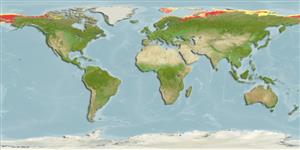Environment: milieu / climate zone / depth range / distribution range
экология
морской; пресноводный; солоноватоводный демерсальный; пределы глубины 0 - 90 m. Polar; 82°N - 63°N, 12°E - 104°W (Ref. 117245)
Northeast Atlantic and Arctic: White Sea and Barents Sea eastward along the coasts of Siberia and North America to Queen Maud Gulf in Arctic Canada. North Pacific: Chukchi and Bering seas to Bristol Bay, Alaska and the northern Sea of Okhotsk.
Length at first maturity / Size / Вес / Возраст
Maturity: Lm 17.0, range 15 - 18.9 cm
Max length : 44.0 cm TL самец/пол неопределен; (Ref. 58426); common length : 25.0 cm TL самец/пол неопределен; (Ref. 117245); наибольший возраст (опубликованны данные): 26 годы (Ref. 117245)
Краткое описание
определительные ключи | морфология | морфометрия
колючие лучи спинного плавника (общее число) : 0; членистые (мягкие) лучи спинного плавника (общее число) : 50 - 62; колючие лучи анального плавника: 1; членистые (мягкие) лучи анального плавника: 35 - 44; позвонки: 37 - 38. Distinguished by the presence of both eyes on the same side of the head, normal scales and generally plain coloration (Ref. 27547). Lateral line with a very low curve above pectoral fin, straight behind and with a short accessory branch on head; 73-76 pores on main portion; it is complete in males but in females as large as about 20 cm it is an open groove on the posterior part of the body (Ref. 10319). Most anterior dorsal ray above eye; anal with an embedded forward-pointing spine before first ray; caudal rounded (Ref. 27547). Eyed side dark olive green to brown, sometimes with scattered black dots or indefinite dark blotches; blind side white, rarely with brown lappings over from the eyed side; fins pale brownish, sometimes with a somewhat yellow tinge or traces of dark spots (Ref. 27547).
A coastal species not found far offshore (Ref. 27547). Occurs at shallow depths on mud bottoms, often in brackish water (Ref. 4705) and frequently entering freshwaters (Ref. 59043). Benthic (Ref. 58426). Feeds on small fishes and bottom invertebrates (Ref. 4705). Moves closer inshore in the evenings, especially on a rising tide (Ref. 27547). Appears to move offshore in the fall and inshore in the spring (Ref. 27547).
Reproduction cycle believed to occur only every second year (Ref. 27547).
Vinnikov, K.A., R.C. Thomson and T.A. Munroe, 2018. Revised classification of the righteye flounders (Teleostei: Pleuronectidae) based on multilocus phylogeny with complete taxon sampling. Molecular phylogenetics and evolution, 125:147-162. (Ref. 122998)
Статус Красного Списка МСОП (Ref. 130435: Version 2024-1)
Угроза для людей
Harmless
Использование человеком
рыболовство: не имеет хозяйственного значения
дополнительная информация
инструменты
Специальные отчеты
Скачать в формате XML
ресурсы в Интернет
Estimates based on models
Preferred temperature (Ref.
123201): -1.7 - 4.3, mean -0.1 °C (based on 2772 cells).
Phylogenetic diversity index (Ref.
82804): PD
50 = 0.7500 [Uniqueness, from 0.5 = low to 2.0 = high].
Bayesian length-weight: a=0.00437 (0.00284 - 0.00671), b=2.97 (2.84 - 3.10), in cm total length, based on LWR estimates for this species & (Sub)family-body (Ref.
93245).
Trophic level (Ref.
69278): 3.4 ±0.1 se; based on diet studies.
устойчивость к внешним воздействиям (Ref.
120179): средний (среднего размера), минимальное время удвоения популяции 1.4-4.4 года (K=0.06; tm=2; Fec=31,000-230,000).
Fishing Vulnerability (Ref.
59153): High vulnerability (64 of 100).
Nutrients (Ref.
124155): Calcium = 29.4 [10.2, 55.1] mg/100g; Iron = 0.302 [0.119, 0.716] mg/100g; Protein = 16.3 [14.8, 17.8] %; Omega3 = 0.173 [0.069, 0.392] g/100g; Selenium = 10.9 [4.0, 31.6] μg/100g; VitaminA = 12 [2, 81] μg/100g; Zinc = 0.565 [0.334, 0.906] mg/100g (wet weight);
